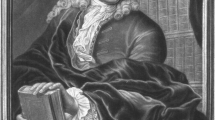Abstract
Purpose
To highlight the most relevant contributions of the Italian Renaissance surgeon Girolamo Fabrizi d’Acquapendente in the field of orthopaedics and traumatology.
Methods
An extensive research on the life and achievements of Girolamo Fabrizi was conducted on University Libraries as well as on electronic databases like PubMed.
Results
Girolamo Fabrizi d’Acquapendente is known for his embryology and physiology studies, particularly on sensory organs and blood circulation. He founded the world’s first permanent anatomical theater established at the University of Padua and inaugurated in 1595. His most notable publications include surgical and definitely orthopedics works such as “De fracturis” (On fractures) and “De luxationibus” (On joint displacement). He outlined some principles of treatment that are still valid nowadays such as anatomical reduction and stabilization of the fracture, that were applied using the equipment available at that time. He described and illustrated maneuvers and instruments, such as pulleys, winches, splint, and bandages. He further depicted the famous “Oplomochlion” (“the armored man”), which is actually a collection of all of the braces used at the time to correct congenital and post-traumatic deformities.
Conclusion
Bracing and prosthetic replacements have accompanied medical history throughout the centuries, from Ancient Egypt to the present, but it was the ingenuity of Renaissance surgeons that pushed biomedical technology to new heights: Girolamo Fabrizi d’Acquapendente was one of the most illustrious contributors to these great achievements.





Similar content being viewed by others
References
Di Matteo B, Tarabella V, Filardo G, Viganò A, Tomba P, Marcacci M (2014) Art and science in the Renaissance: the case of Walther Hermann Ryff. Clin Orthop Relat Res 472(6):1689–1696. https://doi.org/10.1007/s11999-014-3605-y
Hernigou P, Huys M, Pariat J, Jammal S (2017) History of clubfoot treatment, part I: from manipulation in antiquity to splint and plaster in renaissance before tenotomy. Int Orthop 41(8):1693–1704. https://doi.org/10.1007/s00264-017-3487-1
Manzini F, Manzini C, Cesana G, Riva MA (2017) The contribution of intellectuals to the history of traumatology during the renaissance: treatment of femoral fracture through François Rabelais’ glossocomion. Int Orthop 41(2):429–432. https://doi.org/10.1007/s00264-016-3323-z
Hernigou P (2013) Ambroise Paré IV: the early history of artificial limbs (from robotic to prostheses). Int Orthop 37(6):1195–1197. https://doi.org/10.1007/s00264-013-1884-7
Di Matteo B, Tarabella V, Filardo G, Viganò A, Tomba P, Marcacci M (2013) The Renaissance and the universal surgeon: Giovanni Andrea Della Croce, a master of traumatology. Int Orthop 37(12):2523–2528. https://doi.org/10.1007/s00264-013-2111-2
Borghi L (2011) Girolamo Fabrizi d'Acquapendente (c.1533-1619). J Med Biogr 19(2):69. https://doi.org/10.1258/jmb.2010.010016
Zanchin G, Panetto M, Dalla Francesca EH (2015) Echoes from the anatomical theater of Padua: Fabrici on the nervous system. Vesalius. 21(1):54–62
Di Matteo B, Tarabella V, Filardo G, Viganò A, Tomba P, Bragonzoni L, Marcacci M (2015) Art in science: the stage of the human body--the anatomical theatre of Bologna. Clin Orthop Relat Res 473(6):1873–1878. https://doi.org/10.1007/s11999-015-4288-8
Ribatti D (2019) Letter to the editor: Girolamo Fabrici and the discovery of the bursa. Poult Sci 98(10):4514. https://doi.org/10.3382/ps/pez231
Ghosh SK (2015) Human cadaveric dissection: a historical account from ancient Greece to the modern era. Anat Cell Biol 48:153–169. https://doi.org/10.5115/acb.2015.48.3.153
Semenzato C, Dal Piaz V, Rippa Bonati M (1994) Il teatro anatomico, Storia e Restauri. Offset Invicta Limena, Padova, Padua
Gazzaniga V, Marinozzi S (2015) Ortopedia e protesi nella chirurgia di Girolamo Fabrizio d’Acquapendente. GIOT 41:41–45
Author information
Authors and Affiliations
Corresponding author
Additional information
Publisher’s note
Springer Nature remains neutral with regard to jurisdictional claims in published maps and institutional affiliations.
Rights and permissions
About this article
Cite this article
Vandenbulcke, F., Ashmore, K., Cialdella, S. et al. The Iron Man of the Renaissance: the contribution of Girolamo Fabrizi d’Acquapendente. International Orthopaedics (SICOT) 44, 399–402 (2020). https://doi.org/10.1007/s00264-019-04449-0
Received:
Accepted:
Published:
Issue Date:
DOI: https://doi.org/10.1007/s00264-019-04449-0




